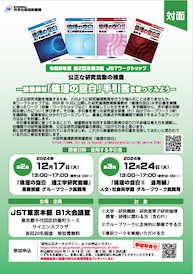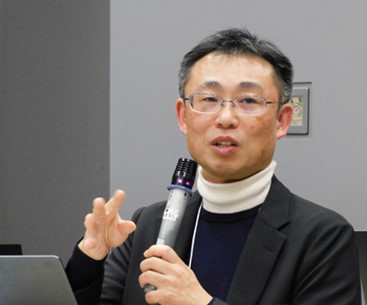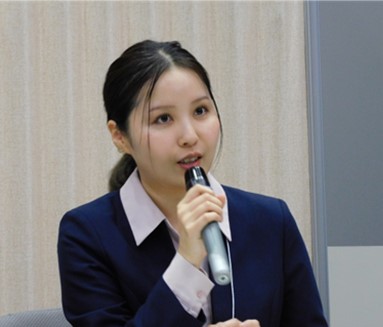Event Reports
The 2nd & 3rd JST Workshop in 2024 on Promoting Activities toward Research Integrity, "Let's use the Guidebooks on Gaps in Ethics."

In this workshop, Prof. Fudano (Waseda University) spoke about the current situations and issues in research ethics education, followed by lectures by the lecturers who supervises JST guidebooks on the key points of its use, and participants were asked to role-play as lecturers using the guidebooks. This report will provide an overview of the workshop.
* See the instructional video and guidebooks of the "Gaps in Ethics" series here.
https://www.jst.go.jp/kousei_p/en/measuretutorial/mt_video_e.html
● Lecture: "Let's use the Guidebooks on Gaps in Ethics"
Professor Jun Fudano, Center for Higher Education Studies, Waseda University (Dec 17th, 24th)

The lecture began with a discussion of the current situations and issues in research integrity education these days. Prof. Fudano cited commissioned survey by the Ministry of Education, Culture, Sports, Science and Technology (MEXT) in FY 2020, and explained that practical research ethics education is required according to the characteristics of the title, position, and research field. He also mentioned the following in the seven challenges identified by the Network for Education and Research Quality (NERQ), a European project on research ethics education: "RCR education is not a 'one size fits all'","RCR is a journey that requires distinct learning pathways for different target groups," and "Training and education alone are not sufficient to stimulate research quality.
He then indicated the importance of setting educational goals and gave two goals for what this workshop aimed for. He mentioned the importance of setting and sharing goals as an important process for learning and for measuring and evaluating effectiveness, and he hoped that participants would also be able to explain their educational goals. He also stated that the ultimate goal of research integrity education is for researchers to be able to make ethical judgments and explain this by introducing the efforts of overseas institutions such as the National Institutes of Health (NIH) and The Office of Research Integrity (ORI), United States.
There are various methods for research integrity education, and the use of case studies is one of the most important, and he used "THE LAB" and the "Gaps in Ethics" series produced by JST as examples of specific methods. He pointed out that one of the advantages of instructional videos is that it helps people think about how they would act if they were there as themselves and also deepens their "values and attitudes" through group discussions.
In closing, he summarized that the goal of research integrity education is not only to prevent research misconduct and Questionable Research Practices (QRPs), but also to have a perspective on Aspirational Ethics on what it means to be a good researcher and what research is for.
● Lecture: "Gaps in Ethics: The Science and Engineering Research Center" Associate Professor Edition, Key Points for Utilizing the Guidebooks (Dec 17th)
Associate Professor Hideki Ichida, Faculty of Liberal Arts, Sciences and Global Education, Osaka Metropolitan University

In the workshop on the 17th, Prof. Ichida, who supervised the guidebooks of "Gaps in Ethics: The Science and Engineering Research Center," talked about the key points of utilizing the guidebooks.
Firstly, he stated that the key to designing research ethics education is to set educational goals and targets as "What/Who" from the perspective of 5W1H (five Ws and one H), and to consider how and what to implement as "How/When/Where." Of these, he indicated that it is important to first clearly determine the target audience for education and then set educational goals corresponding to that audience. He said that sharing educational goals with the target audience and promoting their proactive participation and making the goals specific will also clarify the evaluation criteria for those goals.
He then talked about specific implementation methods and content, from the perspectives of "what will participants take with them" and "what and how will we create" to achieve this. For example, he mentioned how to arrange preparatory work, such as asking participants about their research environment, in the case of an assumed Faculty Development (FD) for faculties. In the discussion of the day's workshop, the participants were also advised to spend time thinking individually first, and to be creative in setting themes. Throughout the lecture, he introduced many specific and practical points and arrangements that may be useful in utilizing the guidebooks from his position as a supervisor of the guidebooks.
● Lecture: "Gaps in Ethics 2: Plagiarism" Humanities and Social Sciences Version, Key Points for Utilizing the Guidebooks (Dec 24th)
Assistant Professor Chie Hikasa, School of Medicine, Shinshu University

In the workshop on the 24th, Prof. Hikasa, who supervised the guidebooks of "Gaps in Ethics 2: Plagiarism, Humanities and Social Sciences Version," talked about the key points of utilizing the guidebooks.
She began by providing the background to the creation of guidebooks, and the motivations and contributing factors to the recent cases of research misconduct.
Prof. Hikasa stated that in addition to acquiring "knowledge" about research integrity through e-learning, it is also necessary to go a step further and have students acquire a "norm consciousness." She pointed out that we need to consider research misconduct with the understanding that people are irrational creatures who make choices even when they know that doing something wrong will later harm them.
Next, she stated that, with regard to research ethics education using the guidebooks, it is important to carefully refine the educational goals and target audience, taking as a starting point what level of participants in what field and position you want them to learn, since their experience and the problems and risks they face may differ depending on their field and position.
In practice, she also described creativity in educational design in consideration of researchers who find it burdensome to attend research integrity education. For example, since there are various tools available these days, she advised that one way is saving time by utilizing tools, such as making preparatory work available for submission from a smartphone during commuting time. When there are participants of various levels, for example, it was suggested that the topic for developing normative consciousness does not have to be difficult. From her position as the supervisor of the guidebooks, she offered many specific suggestions.
Finally, the lecture was concluded by stating that the purpose of research ethics education using this guidebook is to encourage people to think for themselves, exchange opinions with others, and develop ethical judgment.
● Group Work

In the group work sessions held on both days, participants role-played as either the lecturer who provides research ethics education to the Principal Investigator (PI) or the PI (student). Prof. Fudano advised the participants to play firmly the role of lecturers and the participants to play firmly the role of PIs, and to think about what they can do when they bring the results back to their institutions.
As the discussion progressed, with participants taking on the roles of both lecturer and student, the lecturers needed to create an environment in which participants felt comfortable speaking up by encouraging various other people, and the students also spoke up proactively, leading to an exchange of opinions that can be put into practice at research institutions.
● Overall Review
Finally, the lecturers gave general comments.Prof. Fudano said that research ethics education ultimately provides a place for people to think about the meaning of doing research, and one of the tools for this will be instructional videos and guidebooks. He said that it would be good to have a perspective on lab management and consider it as part of training for lab management and better research.
Prof. Ichida said that the group work method of training provides new insights by allowing participants to put themselves in other people's positions. In terms of how to create a place, for example, he said it is important to create an atmosphere that enhances psychological safety.
Prof. Hikasa noted that in training, it may be difficult to set a theme for where people should think, but there are guidebooks for that purpose, and in the guidebooks, there are hints on how to think in this way. He hoped that each institution would use the guidebooks to understand their current situation and analyze what approach would be appropriate for their institution.
Previous JST Workshop Report, The 1st JST Workshop 2024 on Promoting Activities toward Research Integrity, Considering Effective Utilization of Research Ethics Instructional Video "Gray Zones in Research Activities"

